You will be redirected to a Leads.io registration page.

Get up to 3 quotes from our selected suppliers by filling in only 1 form

Save money by comparing quotes and choosing the most competitive offer

Our service is 100% free and with no obligation
- GreenMatch.com
- HVAC
- Heating
Heating: Types and Benefits
Which is the best heating system?
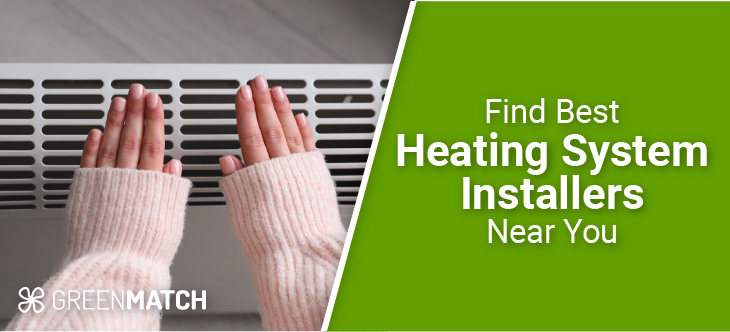
As prices for traditional sources of heating are rising, the time has come to consider renewable heating technologies such as heat pumps, geothermal energy, solar water heating or biomass boilers. Renewable heating solutions can compete with gas and electricity technologies on parameters such as lower costs, decreased carbon emission and improved self-sufficiency. This means that by switching to green energy, you are becoming less dependent on non-renewable energy sources that are subject to increasing public demand, and therefore, are more likely to have unstable and changing prices.
Whether you are just thinking about switching to renewable heating technologies or have already decided to go green, there are a few things you need to know before investing in a new heating system.
Fill in the form in just 1 minute
What about Heating?
Heating, as the name suggests, means all the solutions that enable you to heat your home. In addition to this, heating is also about providing a hot water source for domestic use. There are several heating solutions through which you can generate your green energy at home. This is possible with low or zero-carbon emission technologies, such as wood-burning stoves, heat pumps, geothermal energy, or solar heating systems.
Types of heating systems
Several heating systems are used throughout homes in the US. Each of these heating systems comes with its own benefits. Some of the most common types of heating systems include:
To give you a clearer idea of what these systems are, how they work, and how you can benefit, we’ve discussed each in brief below.
Furnace heating

A furnace heating system is one of the most commonly used heating systems in homes across the US. This system is generally powered by either electricity or fuels such as natural gas, propane, and oil to heat the air inside your home. The furnace comes with a system of ducts and vents which are the source of heat distribution after the heat is generated in the furnace.
The furnace, a major part of the central heating system, is highly efficient, with its efficiency measured by the annual fuel utilization efficiency (AFUE). Modern furnaces claim to have efficiency ratings of up to 98% AFUE, which means that almost all of the fuel used gets converted to heat. This results in a significant reduction in your energy bills and also helps reduce your carbon footprint. Moreover, furnaces are a relatively affordable option, which is why it is one of the most popular choices among homeowners across the US when it comes to heating systems.
There are three types of furnaces:
Single-stage: These furnaces run at a single speed and full capacity all the time, making them quite a noisy system. Moreover, since it runs at full capacity at all times, it generates and distributes the hottest air at the highest velocity.
Two-stage: These furnaces give you the option of having them run at either full capacity or at half the speed. These are relatively quieter and will allow you to maintain balanced temperatures inside your home.
Modulating: These furnaces run by modulating the heat generated and distributed all the time, depending on the temperatures inside and outside your home. This is the most energy efficient furnace option you can choose to install.
What’s more, you can also pair your furnace with a central air conditioning system, which you can install at the same time or add later. As a result, you can enjoy controlled, balanced temperatures inside your home all year round.
Furnaces are relatively easy to install and maintain, which is another advantage of installing them. You will quite easily be able to perform basic maintenance tasks and prolong the lifespan of your furnace.
Boilers
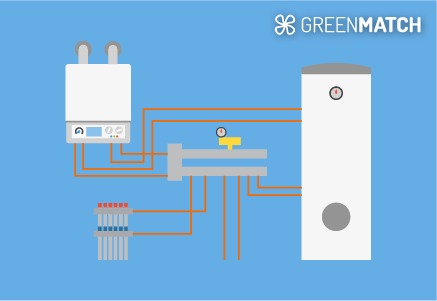
Boilers use water or steam to distribute heat throughout a home or building. They are fueled by natural gas or heating oil and are ideal for colder climates as they provide consistent heat even in the coldest weather. This gives you the benefit of enjoying a highly comfortable and warm home all year round.
Boilers deliver heat directly to radiators, baseboards, or radiant floor systems, which in turn radiate heat into the room. This allows you to enjoy even and comfortable temperatures throughout. Boilers are comparatively less noisy compared to furnaces.
Boilers are also highly energy efficient since they use water or steam to distribute heat. This also makes them more energy efficient than furnaces. This is because water carries higher heat carrying capacity compared to air, which is the primary source of heat distribution in furnaces. Modern boilers are said to have efficiency ratings of up to 98% AFUE.
Boilers are not dependent on ducts and vents, which makes them easier to maintain and also prolongs their lifespan without the risks of duct leaks. Moreover, with fewer parts to the boiler system, maintaining the system becomes fairly easy. You can easily do the basic maintenance yourself, which only helps ensure the boiler continues to work at optimum efficiency for a longer period of time.
One additional benefit of boilers is that it also provides hot water for other uses such as showers and laundry. As a result, having a boiler allows you to save on installing a separate water heater and save on energy bills.
Heat pumps
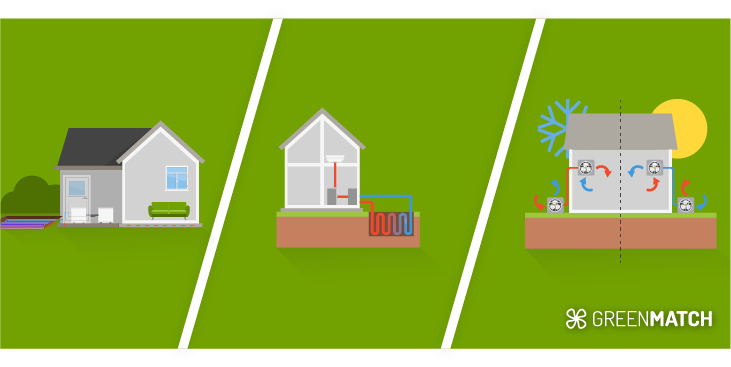
Heat pumps are a system that uses electricity to move heat from one place to another, acting as both a heating and a cooling system. Heat pumps basically extract heat from the air, ground, or water and transfer it into your home, instead of generating heat like the traditional heating systems. During the cold months, it extracts heat from the outside air and transfers it into your home, providing a warmer temperature. In the summer, it reverses the process and maintains a cooler temperature in the home.
There are three main types of heat pumps:
Heat pumps are highly energy efficient and versatile options for homeowners. The energy efficiency of heat pumps is nearly three times that of traditional heating systems. This is because heat pumps simply move heat instead of generating it. Additionally, since it does not use any fuels, there is no emission of greenhouse gas. For homeowners looking to reduce their carbon footprint can also opt for solar power enabled heat pumps.
If you’re looking to go green, you’ve come to the right place. At GreenMatch, we can help you find the right installer for you. All you have to do is fill out the form and we’ll get you up to 3 quotes to compare. Our service is free with no obligation.
Fill in the form in just 1 minute
Radiant heating
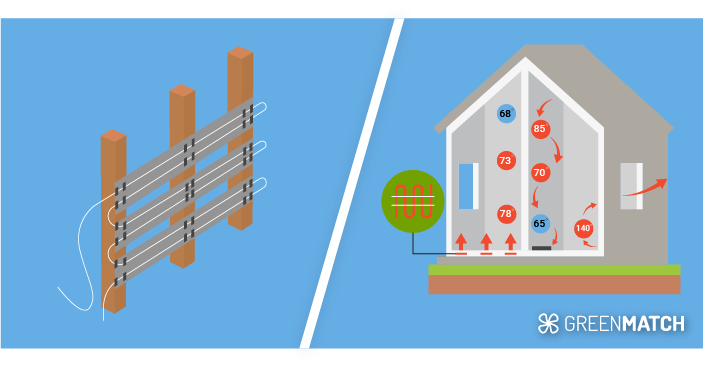
Radiant heating or infrared heating is a heating system that transfers heat through radiation (infrared) to heat your home. Radiant heaters work by heating the surrounding objects and surfaces in a room such as the floors, walls, and furniture, which then radiate heat back into the space.
There are two main types of radiant heating systems commonly used in homes:
Electric radiant heating: These systems generally include electric cables or mats that are installed beneath the flooring or in the walls.
Hydronic radiant heating: These systems consist of a network of pipes laid in a pattern under the floor or in the walls that circulate hot water from a boiler or steam through the floors or walls.
Radiant heating systems can be highly energy-efficient, as they do not can cause heat loss. These systems can also be zoned, which allows you to heat the rooms you are using. Since radiant heaters warm surfaces and objects in a given space rather than the air, you can enjoy more comfortable, balanced, and pleasant temperatures in your home. And since they do not circulate air you can enjoy dust, allergens, and pollutants-free air in your home.
Electric resistance heating

Electric resistance heating uses electric current to generate heat. This system is commonly used in electric space heaters, baseboard heaters, and electric furnaces. It works by passing an electric current through resistive heating elements, such as a coil or a ceramic core. As a result, the coil or ceramic core heats up, radiating heat into the surrounding air. The heat produced through electric resistance heating is distributed through natural convection or radiation in case of baseboard heaters.
The upfront costs for electric resistance systems are low, however, they consume electricity which means they may end up increasing your energy bills. Other than that, this type of heating system calls for easy installation and maintenance. They are 100% energy efficient as all of the electric current consumed is converted into heat, without any loss of current.
These heating systems also come with zoning capabilities. This means that you can heat specific areas in your home without having to heat your entire home. Moreover, these systems are safer and cleaner since they do not produce any emissions of gas or use fuels to run.
Wood-burning and pellet stoves
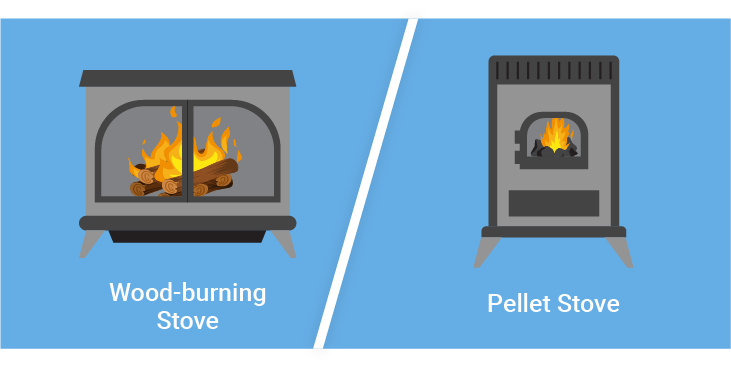
If you’re looking to go green and want an environment friendly option for your heating system, wood-burning or pellet stoves are the perfect choice. These are heating appliances that burn wood or wood pellets to produce heat. The stoves are usually made of cast iron or steel which can be used in a specific room or area of your home. You can either use these stoves as your primary source of heat or a supplemental heating system.
In wood-burning stoves, logs or wood chips are burnt in a firebox heating the air, which circulates around the room. On the other hand, a pellet stove uses wood pellets which are composed of compressed sawdust or other wooden waste. These pellets are placed into a hopper from where they are fed into a combustion chamber. The heat produced is then circulated around the room by a fan.
These stoves are highly cost-effective as wood is a relatively cheaper source of fuel when compared to oil or natural gas. Moreover, if you are using these stoves as a supplemental heating system, it can further help cut down on your overall heating costs. Additionally, burning wood produces fewer pollutants and produces radiant heat, which can be especially beneficial for those suffering from respiratory problems. Wood-burning or pellet stoves also minimize noise pollution as they do not make any noise as forced-air heating systems such as furnaces do.
Choosing the right heating system
Now that you know the different types of heating systems, you must be wondering which would be the right system for your home. Well, deciding the best fit for your home is a daunting task. This decision is dependent on several factors such as:
Climate is one of the major considerations when choosing a heating system. If you’re in an area that sees colder weather, a high-efficiency furnace or a boiler would be a better option for you. On the other hand, if you are experiencing milder climates, then a heat pump or radiant heating system would prove to be the perfect option for you.
The availability of energy sources should also be a consideration when deciding the right heating system for your home. If you are thinking of installing a furnace, it runs on natural gas or oil. The cost and availability of these energy sources will determine whether a furnace would be a good option for you or not. If electricity is cheaper compared to these fuel sources, you may want to consider going for a heat pump or radiant heating system. Wood-burning or pellet stoves may also be a good option in such cases.
The size and existing infrastructure of your home is also a factor that plays a role when deciding on the best heating system. Depending on how big a room or the size of your entire home is, the heating system should be chosen based on its efficiency. Furthermore, if you’re thinking of replacing your existing heating system then the existing infrastructure, such as the ductwork and pipelines needs to be taken into consideration. It would be more cost-effective if you go for the same system in order to fit with the existing infrastructure. However, if renovating, you would have more flexibility in choosing the best heating system.
Cost is always a factor of consideration. You may find that the upfront cost of the heating system is affordable but in the long run, it may be heavy on your pocket. Similarly, the upfront cost of a high-efficient system may be high but in the long run, would prove to be easier on your pocket.
All in all, these factors would play a major role in your decision of choosing the right heating system for your home. However, consulting a qualified HVAC installer can further help you make an informed decision. You can also ensure that your heating system is installed properly and maintained for optimal efficiency and prolonged lifespan.
Finding the right installer is a task just as daunting as deciding the right heating system is. It requires hours of you calling one installer after the other, explaining your requirements and requesting quotes for comparison. At GreenMatch, we can minimize this task to a mere click. All you have to do is click the button below, fill out the form and we’ll get you in touch with up to three installers and their quotes to compare. You will be under no obligation to accept any quotes.
Fill in the form in just 1 minute
Frequently Asked Questions
The most common types of heating systems used in homes across the US are furnaces, boilers, radiant heaters, and heat pumps.
In most cases, heat pumps would be the best fit for heating your older home. However, a professional installer can help you in making an informed decision.
It is said that geothermal heat pumps have the highest lifespan of around 30 years. Furnaces and boilers come next with about 15 to 20 years of lifespan.
Electric resistance heaters are the easiest to install in your homes. They are also portable, making it easier to carry them from one room to another. They do not come with the hassles of installing ductwork, panels, or coils to facilitate heating.
We strive to connect our customers with the right product and supplier. Would you like to be part of GreenMatch?

